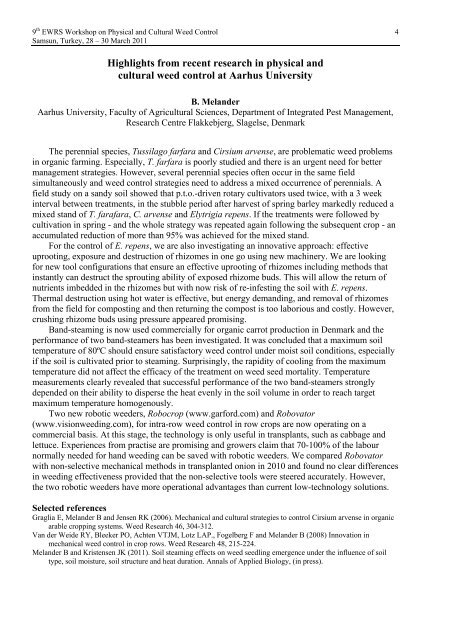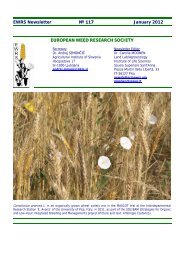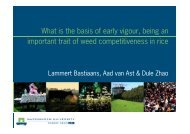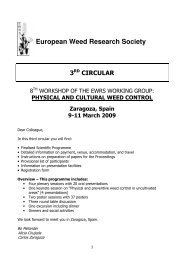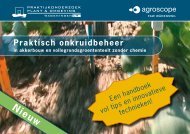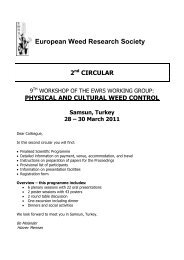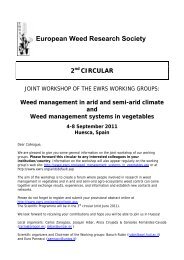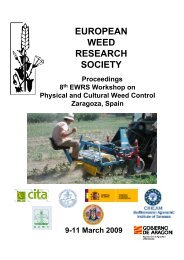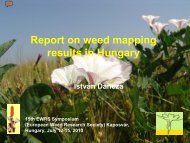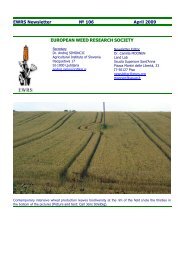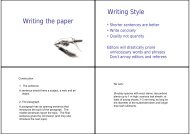Physical and Cultural Weed Control Working Group of - European ...
Physical and Cultural Weed Control Working Group of - European ...
Physical and Cultural Weed Control Working Group of - European ...
Create successful ePaper yourself
Turn your PDF publications into a flip-book with our unique Google optimized e-Paper software.
9 th EWRS Workshop on <strong>Physical</strong> <strong>and</strong> <strong>Cultural</strong> <strong>Weed</strong> <strong>Control</strong> 4<br />
Samsun, Turkey, 28 – 30 March 2011<br />
Highlights from recent research in physical <strong>and</strong><br />
cultural weed control at Aarhus University<br />
B. Mel<strong>and</strong>er<br />
Aarhus University, Faculty <strong>of</strong> Agricultural Sciences, Department <strong>of</strong> Integrated Pest Management,<br />
Research Centre Flakkebjerg, Slagelse, Denmark<br />
The perennial species, Tussilago farfara <strong>and</strong> Cirsium arvense, are problematic weed problems<br />
in organic farming. Especially, T. farfara is poorly studied <strong>and</strong> there is an urgent need for better<br />
management strategies. However, several perennial species <strong>of</strong>ten occur in the same field<br />
simultaneously <strong>and</strong> weed control strategies need to address a mixed occurrence <strong>of</strong> perennials. A<br />
field study on a s<strong>and</strong>y soil showed that p.t.o.-driven rotary cultivators used twice, with a 3 week<br />
interval between treatments, in the stubble period after harvest <strong>of</strong> spring barley markedly reduced a<br />
mixed st<strong>and</strong> <strong>of</strong> T. farafara, C. arvense <strong>and</strong> Elytrigia repens. If the treatments were followed by<br />
cultivation in spring - <strong>and</strong> the whole strategy was repeated again following the subsequent crop - an<br />
accumulated reduction <strong>of</strong> more than 95% was achieved for the mixed st<strong>and</strong>.<br />
For the control <strong>of</strong> E. repens, we are also investigating an innovative approach: effective<br />
uprooting, exposure <strong>and</strong> destruction <strong>of</strong> rhizomes in one go using new machinery. We are looking<br />
for new tool configurations that ensure an effective uprooting <strong>of</strong> rhizomes including methods that<br />
instantly can destruct the sprouting ability <strong>of</strong> exposed rhizome buds. This will allow the return <strong>of</strong><br />
nutrients imbedded in the rhizomes but with now risk <strong>of</strong> re-infesting the soil with E. repens.<br />
Thermal destruction using hot water is effective, but energy dem<strong>and</strong>ing, <strong>and</strong> removal <strong>of</strong> rhizomes<br />
from the field for composting <strong>and</strong> then returning the compost is too laborious <strong>and</strong> costly. However,<br />
crushing rhizome buds using pressure appeared promising.<br />
B<strong>and</strong>-steaming is now used commercially for organic carrot production in Denmark <strong>and</strong> the<br />
performance <strong>of</strong> two b<strong>and</strong>-steamers has been investigated. It was concluded that a maximum soil<br />
temperature <strong>of</strong> 80ºC should ensure satisfactory weed control under moist soil conditions, especially<br />
if the soil is cultivated prior to steaming. Surprisingly, the rapidity <strong>of</strong> cooling from the maximum<br />
temperature did not affect the efficacy <strong>of</strong> the treatment on weed seed mortality. Temperature<br />
measurements clearly revealed that successful performance <strong>of</strong> the two b<strong>and</strong>-steamers strongly<br />
depended on their ability to disperse the heat evenly in the soil volume in order to reach target<br />
maximum temperature homogenously.<br />
Two new robotic weeders, Robocrop (www.garford.com) <strong>and</strong> Robovator<br />
(www.visionweeding.com), for intra-row weed control in row crops are now operating on a<br />
commercial basis. At this stage, the technology is only useful in transplants, such as cabbage <strong>and</strong><br />
lettuce. Experiences from practise are promising <strong>and</strong> growers claim that 70-100% <strong>of</strong> the labour<br />
normally needed for h<strong>and</strong> weeding can be saved with robotic weeders. We compared Robovator<br />
with non-selective mechanical methods in transplanted onion in 2010 <strong>and</strong> found no clear differences<br />
in weeding effectiveness provided that the non-selective tools were steered accurately. However,<br />
the two robotic weeders have more operational advantages than current low-technology solutions.<br />
Selected references<br />
Graglia E, Mel<strong>and</strong>er B <strong>and</strong> Jensen RK (2006). Mechanical <strong>and</strong> cultural strategies to control Cirsium arvense in organic<br />
arable cropping systems. <strong>Weed</strong> Research 46, 304-312.<br />
Van der Weide RY, Bleeker PO, Achten VTJM, Lotz LAP., Fogelberg F <strong>and</strong> Mel<strong>and</strong>er B (2008) Innovation in<br />
mechanical weed control in crop rows. <strong>Weed</strong> Research 48, 215-224.<br />
Mel<strong>and</strong>er B <strong>and</strong> Kristensen JK (2011). Soil steaming effects on weed seedling emergence under the influence <strong>of</strong> soil<br />
type, soil moisture, soil structure <strong>and</strong> heat duration. Annals <strong>of</strong> Applied Biology, (in press).


